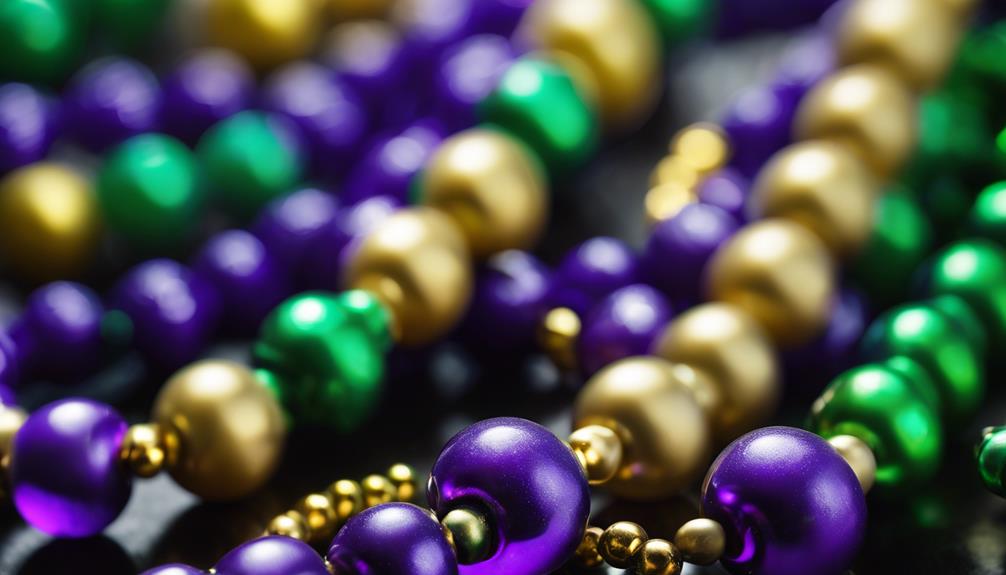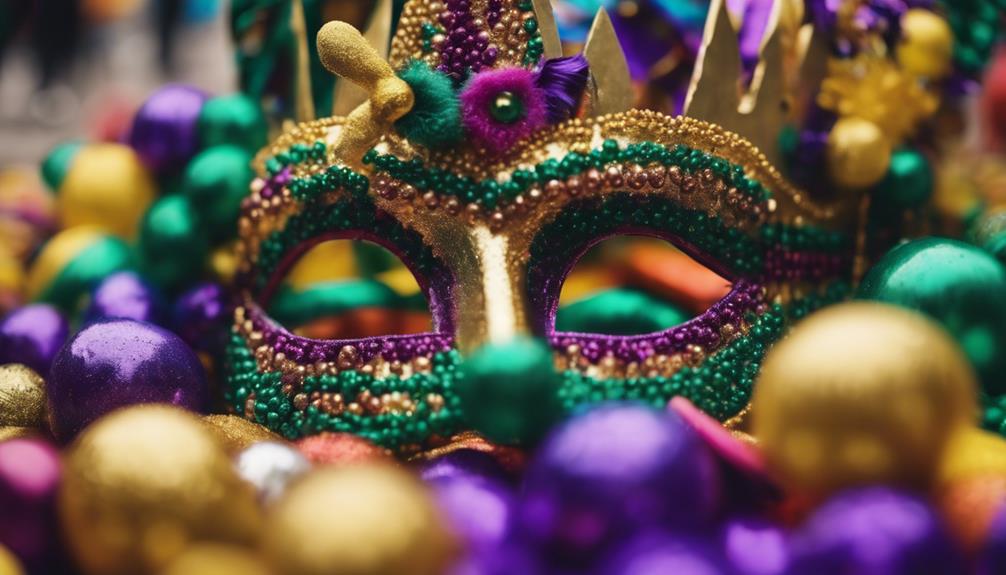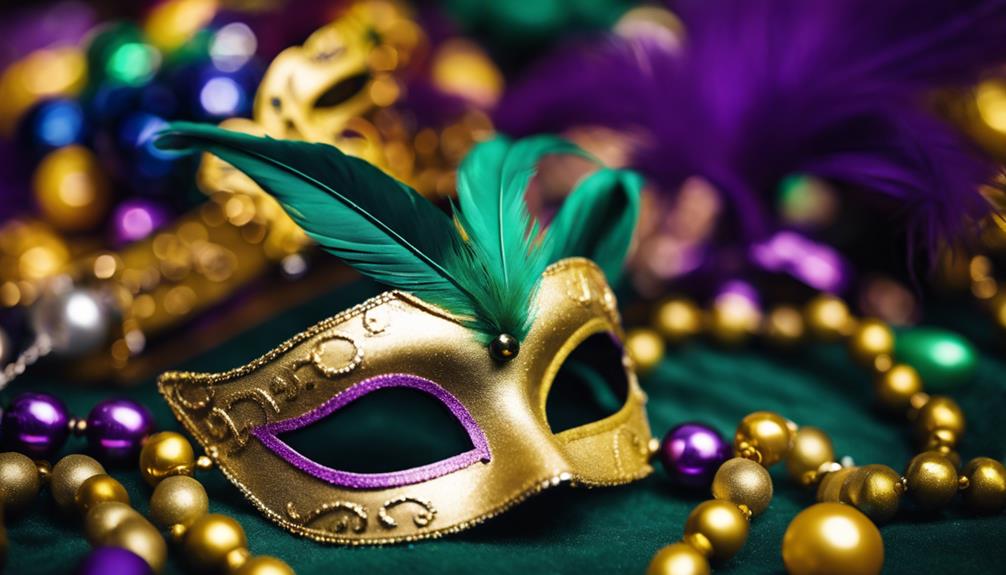Mardi Gras symbols from Europe have *deep meanings*. **Masks**, **beads**, and **colors** show justice, faith, and power. The **Fleur de Lis** connects to Louisiana’s French Catholic roots. **Purple** stands for justice, **green** for faith, and **gold** for power. Throws like **doubloons** became popular in the 19th century. **Masks** have been key since then, helping *bring everyone together* even during segregation. These symbols *celebrate and let you forget your identity*. Discover the *rich history* and importance of Mardi Gras symbols—*uncover their fascinating origins and meanings*.
Key Takeaways
- Mardi Gras colors symbolize justice, faith, and power.
- Traditional throws like doubloons are iconic treasures.
- Masks signify inclusivity and unity in celebration.
- Iconic figures represent social norms and reverence.
- Symbols originate from European traditions in Louisiana.
Historical Origins of Mardi Gras Symbols
Tracing back to European traditions introduced to Louisiana, the historical origins of Mardi Gras symbols reveal a rich cultural tapestry. Mardi Gras symbols such as masks, beads, and colors have deep-rooted connections to the traditions brought over from Europe. These symbols hold significant historical importance, dating back to the 1870s.
The colors of Mardi Gras, purple, green, and gold, symbolize justice, faith, and power, respectively. The Fleur de Lis, another prominent symbol, reflects the French Catholic heritage intertwined with Louisiana's culture. Additionally, Mardi Gras throws like doubloons and trinkets originated in the late 19th century as festive trinkets tossed from floats during the celebrations.
The cultural melting pot of French, Spanish, and Creole influences in Louisiana has shaped the unique and vibrant Mardi Gras symbols that continue to be cherished and celebrated today.
Symbolism Behind Mardi Gras Colors

The historical origins of Mardi Gras symbols, particularly the colors of purple, green, and gold, carry profound symbolic meanings that reflect values deeply intertwined with the Catholic faith. Purple symbolizes justice, green represents faith, and gold signifies power in Mardi Gras tradition.
These colors were first chosen in 1872 by the Rex Krewe to honor a visiting Russian Grand Duke. Purple, associated with royalty, embodies the concept of justice. Green, reminiscent of spring, embodies faith. Gold, mirroring the color of a king's crown, represents power.
These colors have become deeply rooted in the Catholic faith, and during Mardi Gras celebrations, they hold significant symbolic importance. The vibrant hues of purple, green, and gold not only add a festive flair to the festivities but also serve as a reminder of the values and beliefs that underpin Mardi Gras traditions.
Significance of Traditional Mardi Gras Throws

Embellished with intricate designs and symbols, traditional Mardi Gras throws play a significant role in enhancing the festive atmosphere of the celebrations. These throws are not just mere trinkets but highly sought-after treasures that add excitement to the Mardi Gras parade experience. The krewes, such as the Muses and Nyx, have signature throws like hand-decorated high heel shoes and purses named after the Greek goddess of the night, respectively. The Rex Organization's aluminum doubloons are iconic in Mardi Gras culture. In addition to these, various krewes introduce unique throws like shrimp boots, sunglasses, and genie lamps during parades. These throws are not only fun collectibles but also symbolize the generosity and spirit of sharing during the Mardi Gras festivities. Their vibrant colors and intricate designs captivate parade-goers, creating an atmosphere of joy and celebration.
| Traditional Mardi Gras Throws | Krewe |
|---|---|
| Hand-decorated high heel shoes | Muses |
| Embellished purses | Nyx |
| Aluminum doubloons | Rex |
| Shrimp boots, sunglasses, genie lamps | Various Krewes |
Cultural Meaning of Mardi Gras Masks

During Mardi Gras celebrations, the cultural significance of masks emerges as a symbol of inclusivity and escape from personal identities. Mardi Gras masks in Louisiana date back to the 19th century, playing an essential role during times of segregation. They enable individuals of all races and social classes to participate in Mardi Gras festivities, fostering a sense of freedom.
Wearing masks during Mardi Gras allows for a temporary escape from personal identities, contributing to the unique identity of the region. The vibrant colors and intricate designs of Mardi Gras masks are instantly recognizable and integral to the celebration. Overall, Mardi Gras masks hold deep cultural meaning in Louisiana, embodying a spirit of unity and collective celebration where individuals can set aside their differences and come together in a shared experience of joy and revelry.
Interpretation of Iconic Mardi Gras Figures

What significance do iconic Mardi Gras figures hold in the cultural tapestry of the celebrations?
These figures play an essential role in expressing the rich meaning of Mardi Gras, going beyond mere decorations on parade floats.
The 'Lord of Misrule' embodies the temporary overturning of social norms during the festivities, adding a layer of unpredictability and revelry.
Krewe members, taking on roles like 'Captains' and 'Committeemen,' orchestrate and participate in Mardi Gras events, showcasing a sense of community and organization behind the mask.
The tradition of 'Carnival Balls' with rituals and themed parades reflects social hierarchies through items like the 'Dance Card,' illustrating status and inclusion.
The Zulu Social Aid and Pleasure Club's 'Big Shot of Africa' figure symbolizes reverence and tradition within their celebrations.
Additionally, the 'Boeuf Gras' tradition signifies indulgence and feasting ahead of the fasting period of Lent, highlighting themes of abundance and enjoyment in the midst of the festivities.
Frequently Asked Questions
What Do the Symbols of Mardi Gras Mean?
The symbols of Mardi Gras hold significant meanings. Purple symbolizes justice, green stands for faith, and gold represents power.
The Fleur de Lis signifies purity and is linked to Mary's title as Queen of Heaven.
King Cake represents the richness of the diet given up during Lent.
Mardi Gras, celebrated the day before Ash Wednesday, is a time for feasting before the start of the Lenten fasting period.
Do Mardi Gras Beads Have a Meaning?
Mardi Gras beads do have meanings. They symbolize prosperity, faith, and power.
During parades, beads are thrown to spread joy and unity. The tradition of collecting beads adds to the festive atmosphere.
Beads come in various colors, each representing virtues like justice, faith, and strength. Participants wear beads to embody the spirit of Mardi Gras and its values.
What Represents Mardi Gras?
Mardi Gras is represented by festive colors of purple, green, and gold symbolizing justice, faith, and power. It signifies a day of feasting before the fasting of Lent.
Traditional King Cake embodies the richness of diet given up during Lent. The Fleur de Lis symbolizes purity and is associated with Mary's title as Queen of Heaven.
Louisiana's rich French Catholic history influences the symbols and traditions of Mardi Gras.
What Do Bead Necklaces Mean in New Orleans?
Bead necklaces in New Orleans hold significant meanings during Mardi Gras. They symbolize camaraderie, celebration, and unity, often thrown from parade floats to spectators. Different colors carry specific symbolism: purple for justice, green for faith, and gold for power.
Collecting these beads has become a treasured tradition, with some creating elaborate displays at home. Catching these necklaces during parades adds an element of excitement to the festive atmosphere.
What are the similarities and differences between Mardi Gras symbols and Nordic symbols?
Mardi Gras symbols and Nordic symbols have both similarities and differences. Both use colorful imagery and represent cultural traditions. However, Mardi Gras symbols are often associated with celebration and revelry, while Nordic symbols tend to have deeper cultural and mythological meanings. Understanding nordic symbols and meanings unlocked can provide insight into ancient Scandinavian beliefs and folklore.
Conclusion
To sum up, the symbols of Mardi Gras hold deep historical and cultural significance. From the vibrant colors representing different themes to the traditional throws and masks, each element adds to the rich tapestry of this festive celebration.
Just as a Mardi Gras parade dazzles with its colorful floats and costumes, the symbols behind them paint a picture of tradition and community spirit that continues to captivate audiences worldwide.
Let the spirit of Mardi Gras inspire you and ignite your imagination!










